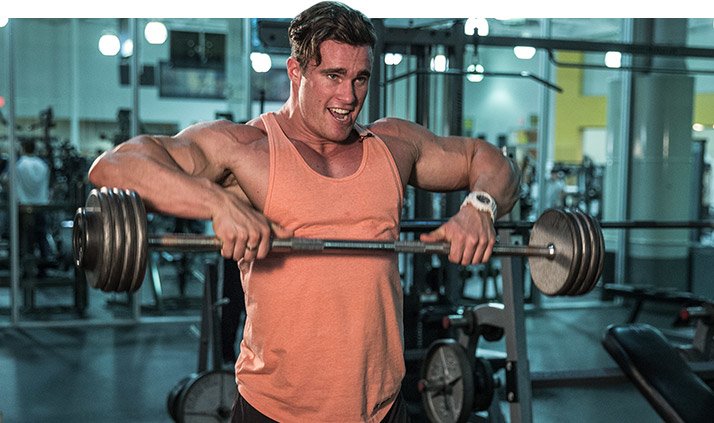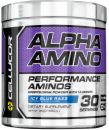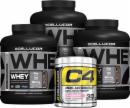
6 Ways To Last Longer In The Gym
Maximize your time in the gym with these athlete-approved tips.
Fatigue is the worst enemy of any motivated gym-goer. You head into the gym ready to crush your workout, give it everything you've got, and follow your plan to a T. You have every intention of pushing your body to the limit. Yet as soon as that first sign of fatigue sets in, you hit a wall.
Learning how to push through fatigue—or prevent it from coming on so quickly in the first place—separates the good from the great. To help you achieve greatness and keep signs of exhaustion at bay, follow these tips from some of the top athletes in the business who have perfected ways to last longer in the gym.
Supplement Smart
To help increase his endurance, IFBB pro physique competitor Craig Capurso turns to supplementation. "I increase my intra-workout endurance by supplementing with BCAAs and caffeine, both of which have been shown to provide you with the ability to reduce fatigue and help your workouts last longer," he says.1,2
BCAAs provide the body with important amino acids, specifically leucine. BCAAs prevent muscle breakdown and provide muscle tissues with a source of fuel. Additionally, taking BCAAs during your workout can help to combat central fatigue, which in turn can help you maintain your training intensity.1

Caffeine increases energy, focus, drive, and circulation. Just pay attention to dosage—this is one product where you can get too much of a good thing. Research suggests taking 1.5-2.5 milligrams per pound of body weight, which translates roughly to 275-460 milligrams of caffeine for a 185-pound male, or 215-365 milligrams for a 145-pound female.2
Also, don't overlook the power of a good pre-workout supplement. The right mix of ingredients can help you defy fatigue without a problem. "My favorite pre-workout is C4 Ripped," says fitness model Jen Jewell. "It gives me that extra boost on strength-training days while also helping me burn fat."
Stay Persistent
Another tip Capurso lives by is training past the burn. "I always train past the point of typical stoppage," he says. "While most people train until they feel that lactic-acid burning sensation, I train until I can barely breathe." Having that "Don't give up" mentality when things get hard is all part of training your body to become truly great.
Time Your Sugar Intake

Sugars are often bad news for your diet, but one time they can actually be helpful is during your workout.
"If I feel myself slipping during one of my longer two-hour training sessions, I'll grab some fat-free candy to give myself an extra boost of energy," explains USAPL powerlifter Karina Baymiller, who cites Sour Patch Kids as her favorite go-to candy. "Fat-free candy is great because it digests quickly and gives an excellent spike in energy."
Keep in mind that a little sugar goes a long way. Eat too much candy, and you could be packing on body fat with each workout you do, thus working against your goals of getting leaner and more defined.
Eat Before You Lift
In addition to adding some intra-workout sugars, Baymiller also keeps her pre-workout meal on track. "To fuel my high-volume and intense-powerlifting workouts, I make sure my pre-workout meal is a good one," she says. "It's when I consume about 25 percent of my carbs for the day."
Baymiller pairs this high dose of carbs with about 25-35 grams of lean protein, while being sure to give her body enough time to digest the meal prior to hitting the gym. Human digestion is very individualized. A good rule of thumb is to consume less fiber right before training. For larger meals, allow at least 60-90 minutes to digest.
Train Rested
As obvious as it may sound, make sure you aren't setting yourself up for fatigue by heading into the gym drained. "You'll tire out much faster if you've been working on your feet all day," explains bodybuilder Calum von Moger. "I used to get so tired after working that I'd sleep in my car for half an hour before entering the gym."

While you may not have time for a catnap in your day, make sure you time your workouts so you aren't going into the gym in a highly fatigued state. And if you really aren't recovered from the day before, don't push it. Sometimes an unplanned rest day is actually better than one workout too many.
Hydrate
Hydration is another factor that gets overlooked too often. "Staying hydrated has a number of benefits to your overall health and fitness, and prior to a workout session, it can be just as important as proper nutrition," Jewell explains. "I always drink water before, during, and of course after my workout."
Aim to drink 1-2 cups of water an hour or two prior to your workout, one cup of water for every 20 minutes or so of intense activity you do, and another 1-2 cups in the hours that follow.3
To adequately replenish fluid lost during exercise, weigh yourself before and after working out. Consume 16 ounces (two cups) for every pound lost during your workout.3
If you're prone to sweating heavily, consider drinking an electrolyte beverage to ensure that you maintain proper potassium and sodium levels.
References
- Crowe, M.J., Weatherson, J.N. & Bowden, B.F. (2006). Effects of dietary leucine supplementation on exercise performance. European Journal of Applied Physiology, 97(6), 664-672.
- Graham, T.E. & Spriet, L.L. (1995). Metabolic, catecholamine, and exercise performance responses to various doses of caffeine. Journal of Applied Physiology, 78, 867-74.
- Casa, D.J., Armstrong, L.E., Hillman, S.K., Montain, S.J., Reiff, R.V., Rich, B.S.E., Roberts, W.O. & Stone, J.A., National Athletic Trainer's Association Position Statement: Fluid Replacement for Athletes. Journal for Athletic Training, 35(2), 212-224.



